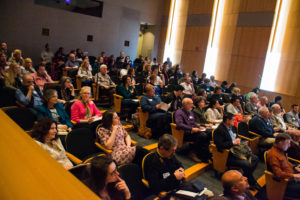 Thanks to the generosity of DCSWA members, DCSWA was able to provide scholarships to a team of early-career writers to document Professional Development Day 2018. Read on for writeups of the panels and plenary sessions.
Thanks to the generosity of DCSWA members, DCSWA was able to provide scholarships to a team of early-career writers to document Professional Development Day 2018. Read on for writeups of the panels and plenary sessions.
Morning Plenary
Kimberly Kowal Arcand: “Exploring Hidden & Exotic Worlds: How Astronomical Data Transports Us”
Kim Arcand, visualization lead for NASA’s Chandra X-ray Observatory, explained how NASA experts are using Chandra observation data to tell stories about the high-energy universe. Her talk touched on the entire process, from the moment X-ray photons travel away from a high-energy interstellar object, such as an exploded star, to when the emissions reach the Chandra X-ray Observatory, and finally the data processing and creation of a scientifically accurate visual representation at the Chandra X-ray Center. Read more…
Covering sexual harassment
Sexual harassment is an issue that is found to be common in the sciences, but is not often discussed. To address this problem, DCSWA organized a session at their 2018 Professional Development Day that included a panel of four science journalists: April Simpson of Current, Andrea Widener of Chemical & Engineering News, and Meredith Wadman and Elizabeth Culotta, both from Science. Sara Reardon of Nature moderated the session. Read more…
Launching collaborative projects in your newsroom
“Check your ego at the door,” said Ben Weider, providing sage advice on approaching collaborations at DCSWA’s 2018 Professional Development Day. Weider, a data reporter for McClatchy, emphasized how important it is to acknowledge the strengths of all parties involved in a project for a successful collaboration. Read more…
Covering conflicts of interest in science
Conflicts of interest are a minefield science writers need to navigate—whether you’re hiring a freelancer, verifying the integrity of a source, or keeping tabs on government officials. The experts on this panel discussed what constitutes a conflict of interest and how to handle them when they crop up. Read more…
Afternoon Plenary
Rick Borchelt, “Guide, Pride, Hide: Evolving Roles for Federal PIOs”
Rick Borchelt, director of communications and public affairs for the Department of Energy’s Office of Science, provided a historical context that blurred the line between early science journalism and PIOs, described where the role of a PIO came from, and explored what it means to be a PIO today. To accomplish this, he shared historical anecdotes and personal reflections from his career as a communications officer at various federal agencies. Borchelt also implored the audience to quit using the term PIO, as it does not reflect an actual job description, but instead connotes more of a tribal identity. Read more…
Visual storytelling
A picture may be worth a thousand words, but you probably need fewer words than you think. Multimedia editors from Science and National Geographic helped unpack the mechanics behind using videos, graphics, and photos to tell stories at the annual DCSWA Professional Development Day on Saturday, April 7, 2018. Read more…
Turning historical science stories into books
Though many have come across works such as The Immortal Life of Henrietta Lacks, Hidden Figures, and The Poisoner’s Handbook, few may think of “science writing” when considering these stories. So where does historical science literature fit in the scope of science writing and how does an aspiring author go about writing a book? Read more…
Incorporating narrative into science writing
Moderator, DCSWA board member, and freelance writer and editor Mitch Waldrop began the afternoon break out session on narrative storytelling with an anecdote about boredom. The session, however, which featured Olivia Ambrogio, the manager of the Sharing Science program at the American Geophysical Union, and National Geographic contributing writer Yudhijit Bhattacharjee, was riveting. Read more…
Writing killer ledes
The lede is arguably the most important part of any story, particularly news stories or press releases, because most readers will decide whether or not to keep reading based on the first few sentences. To keep the readers’ attention, a lede needs to be both interesting and informative, and most importantly, tailored to the story’s audience. Read more…

Sorry, comments are closed for this post.